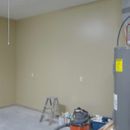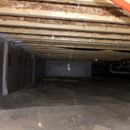Can an HRV be installed in a garage in climate zone 5a?
I just purchased a new spec house and I’m going to install an HRV to improve the indoor air quality. The house is at the very bottom edge of climate zone 5a.
Would be okay to install the HRV in the garage? The AHU and furnace are in the garage along with the water heater, so this would be the easiest place to install the HRV. The installation manual for the Fantech HRV I am considering says it should be installed in a “heated” space but it doesn’t specify a temperature.
I have called about 20 HVAC contractors in the area and none have much experience installing HRVs so it’s difficult to get local advice. I’ve attached a picture of the garage interior where the furnace equipment is located. I don’t think the garage is insulated but I will check soon. I’ve also attached a picture of the insulated and sealed crawlspace, which would be the alternative installation location (albeit less convenient for routine maintenance). The house is small and there is not a good place to install the HRV indoors. Any suggestions or advice would be greatly appreciated.
GBA Detail Library
A collection of one thousand construction details organized by climate and house part











Replies
Patrick,
If the HRV needs to be installed in a heated space, then you can't install it in an unheated garage. But don't take my word for it; call up the manufacturer and ask their tech help people the same question.
Besides the fact that garages get cold during the winter, you have another problem -- an indoor air quality problem. Frankly, it's always a bad idea to put any type of air handling equipment in a garage, including your furnace and air handler. It's extremely difficult to seal all of the seams between a furnace and furnace plenums, so there are many opportunities for garage air to get into your ducts. Since you will be operating an internal combustion engine in your garage, as well as storing gasoline, paint, herbicides, and solvents in there, the furnace belongs somewhere else.
Thanks Martin, I am also concerned about having the furnace in the garage for the same reasons you mention. Unfortunately, that concern didn't occur to me before buying the house. The duct connections are not sealed well and sealing them is also on my to-do list. I suspect the furnace cabinet will still be leaky.
I thought about building a mechanical closet around the equipment, connecting it to the home interior which is just behind that wall, and isolating it from the garage with air sealing and insulation (I read about a similar idea on a thread here today). But that might be more effort than necessary if there is a better way to seal the existing equipment?
About the HRV, I called Fantech and left a message with one of their techs. I suspect the answer will be to keep the HRV above 50 F or so (which is what some other HRV installation manuals specify) so I am leaning toward the crawlspace installation. Even though the crawlspace isn't heated, it is well insulated and I think that it will stay significantly above freezing in the winter, maybe even above 50 F.
Fantech just called back -- the HRV needs to be in a "conditioned space" to prevent freezing and condensation. The crawlspace isn't conditioned, so now it's back to the drawing board…